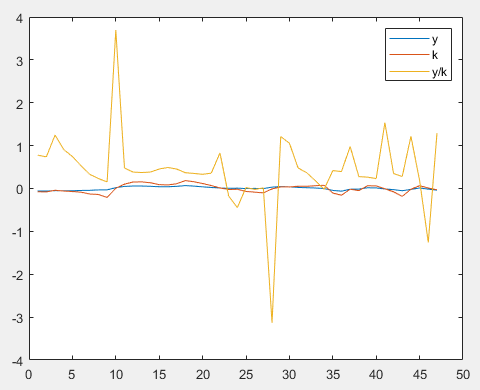this is the text:
%define whether to use interest rate or money growth rate rule
@#define money_growth_rule=0
var pi1 {\pi} (long_name=‘inflation’)
y_gap {\tilde y} (long_name=‘output gap’)
y_nat {y^{nat}} (long_name=‘natural output’) //(in contrast to the textbook defined in deviation from steady state)
y {y} (long_name=‘output’)
g {g} (long_name=‘output_growth’)
r_nat {r^{nat}} (long_name=‘natural interest rate’)
r_real {r^r} (long_name=‘//real interest rate’)
i1 {i} (long_name=‘nominal interrst rate’)
n {n} (long_name=‘hours worked’)
m_real {m-p} (long_name=‘real money stock’)
m_growth_ann {\Delta m} (long_name=‘money growth annualized’)
@#if money_growth_rule==0
nu {\nu} (long_name=‘AR(1) monetary policy shock process’)
@#else
money_growth {\Delta m_q} (long_name=‘money growth’)
@#endif
a {a} (long_name=‘AR(1) technology shock process’)
r_real_ann {r^{r,ann}} (long_name=‘annualized real interest rate’)
i_ann {i^{ann}} (long_name=‘annualized nominal interest rate’)
r_nat_ann {r^{nat,ann}} (long_name=‘annualized natural interest rate’)
pi_ann {\pi^{ann}} (long_name=‘annualized inflation rate’)
z
;
varexo eps_a {\varepsilon_a} (long_name=‘technology shock’)
@#if money_growth_rule==0
eps_nu {\varepsilon_\nu} (long_name=‘monetary policy shock’)
@#else
eps_m {\varepsilon_\m} (long_name=‘money growth rate shock’)
@#endif
eps_z {\varepsilon_\z} (long_name=‘money growth rate shock’)
;
parameters alppha {\alppha} (long_name=‘capital share’)
betta {\beta} (long_name=‘discount factor’)
rho_a {\rho_a} (long_name=‘autocorrelation technology shock’)
@#if money_growth_rule==0
rho_nu {\rho_{\nu}} (long_name=‘autocorrelation monetary policy shock’)
@#else
rho_m {\rho_{m}} (long_name=‘autocorrelation monetary growth rate shock’)
@#endif
siggma {\sigma} (long_name=‘log utility’)
phi {\phi} (long_name=‘unitary Frisch elasticity’)
phi_pi {\phi_{\pi}} (long_name=‘inflation feedback Taylor Rule’)
phi_y {\phi_{y}} (long_name=‘output feedback Taylor Rule’)
eta {\eta} (long_name=‘semi-elasticity of money demand’)
epsilon {\epsilon} (long_name=‘demand elasticity’)
theta {\theta} (long_name=‘Calvo parameter’)
;
%----------------------------------------------------------------
% Parametrization, p. 52
%----------------------------------------------------------------
siggma = 1;
phi=1;
phi_pi = 1.5;
phi_y = .5/4;
theta=2/3;
@#if money_growth_rule==0
rho_nu =0.5;
@#else
rho_m=0.5;
@#endif
rho_a = 0.9;
betta = 0.99;
eta =4;
alppha=1/3;
epsilon=6;
sig_z = 0.0109 ;
%----------------------------------------------------------------
% First Order Conditions
%----------------------------------------------------------------
model(linear);
//Composite parameters
#Omega=(1-alppha)/(1-alppha+alpphaepsilon); //defined on page 47
#psi_n_ya=(1+phi)/(siggma(1-alppha)+phi+alppha); //defined on page 48
#lambda=(1-theta)(1-bettatheta)/thetaOmega; //defined on page 47
#kappa=lambda(siggma+(phi+alppha)/(1-alppha)); //defined on page 49
//1. New Keynesian Phillips Curve eq. (21)
pi1=bettapi1(+1)+kappay_gap;
//2. Dynamic IS Curve eq. (22)
y_gap=-1/siggma*(i1-pi1(+1)-r_nat)+y_gap(+1);
//3. Interest Rate Rule eq. (25)
@#if money_growth_rule==0
i1=phi_pipi1+phi_yy_gap+nu;
@#endif
//4. Definition natural rate of interest eq. (23)
r_nat=siggmapsi_n_ya(a(+1)-a);
//5. Definition real interest rate
r_real=i1-pi1(+1);
//6. Definition natural output, eq. (19)
y_nat=psi_n_yaa;
//7. Definition output gap
y_gap=y-y_nat;
//8. Monetary policy shock
@#if money_growth_rule==0
nu=rho_nunu(-1)+eps_nu;
@#endif
//9. TFP sh
a=rho_aa(-1)+eps_a;
//10. Production function (eq. 13)
y=a+(1-alppha)n;
//11. Money growth (derived from eq. (4))
m_growth_ann=4(y-y(-1)-eta(i1-i1(-1))+pi1);
//12. Real money demand (eq. 4)
m_real=y-etai1;
@#if money_growth_rule==1
//definition nominal money growth
money_growth=m_real-m_real(-1)+pi1;
//exogenous process for money growth
money_growth=rho_m(money_growth(-1))+eps_m;
@#endif
//13. Annualized nominal interest rate
i_ann=4i1;
//14. Annualized real interest rate
r_real_ann=4r_real;
//15. Annualized natural interest rate
r_nat_ann=4r_nat;
//16. Annualized inflation
pi_ann=4pi1;
g = y - y(-1) + z;
z = eps_z ;
end;
%----------------------------------------------------------------
% define shock variances
%---------------------------------------------------------------
shocks;
@#if money_growth_rule==0
var eps_nu = 0.25^2; //1 standard deviation shock of 25 basis points, i.e. 1 percentage point annualized
@#else
var eps_m = 0.25^2; //1 standard deviation shock of 25 basis points, i.e. 1 percentage point annualized
@#endif
var eps_a = 1^2; //unit shock to technology
var eps_z = sig_z^2 ;
end;
%----------------------------------------------------------------
% steady states: all 0 due to linear model
%---------------------------------------------------------------
resid;
steady;
check;
%----------------------------------------------------------------
% generate IRFs, replicates Figures 3.1, p. 53 (interest rate rule)
% 3.3, p. 57 (money growth rule)
%----------------------------------------------------------------
@#if money_growth_rule==0
stoch_simul(order = 1,irf=15) y pi1 i1 ;
@#else
stoch_simul(order = 1,irf=15) y pi1 i1 ;
@#endif
shocks;
@#if money_growth_rule==0
var eps_nu = 0; //shut off monetary policy shock
@#else
var eps_m = 0; //shut off monetary policy shock
@#endif
var eps_a = 1^2; //unit shock to technology
var eps_z = sig_z^2 ;
end;
%----------------------------------------------------------------
% generate IRFs, replicates Figures 3.2, p. 55 (interest rate rule)
% 3.4, p. 59 (money growth rule)
%----------------------------------------------------------------
stoch_simul(order = 1,irf=15,irf_plot_threshold=0) y pi1 i1 n a ;
write_latex_dynamic_model;
varobs y i1 pi1;
% Load the data file (assuming ‘data.mat’ as an example filename)
% Make sure ‘data.mat’ contains a MATLAB table named ‘data’
% Define the estimated parameters
estimated_params;
betta, beta_pdf, 0.99, 0.02;
stderr eps_nu, normal_pdf, 0.01, inf;
stderr eps_a,0.4618,0.01,3,INV_GAMMA_PDF,0.1,2;
stderr eps_z,0.6090,0.01,3,INV_GAMMA_PDF,0.1,2;
end;
% Perform the estimation
%estimation(datafile=data, mode_compute=0, mh_replic=2000,
%mh_nblocks=2, mh_drop=0.1, mh_jscale=2.5, conf_sig=0.95, bayesian_irf, irf=20);
estimation(optim=(‘MaxIter’,200),datafile=data,mode_compute=0,
first_obs=1, presample=4,lik_init=2,prefilter=0,mh_replic=0,mh_nblocks=2,
mh_jscale=0.20,mh_drop=0.2, conf_sig=0.95, bayesian_irf,
irf=0, nograph, nodiagnostic, tex);
shock_decomposition y;
